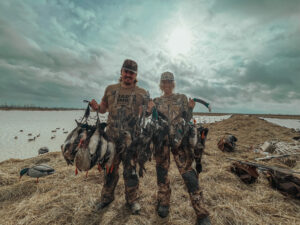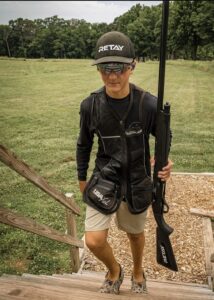
By: T.J. Rademacher

Goldeneye are typically a bonus bird for most diver hunters. They are typically more drawn to their own kind and are not as likely to fully commit to a spread of mixed blocks. Many shots are taken at passing ranges for folks more interested in the other diving duck varieties. For the Last few years I have ended up on waterways chasing divers on both the Mississippi and Central flyways. Out of necessity I was forced to figure out the goldeneye game because the other birds were stale or not moving as much. Here is what I know now after spending some time targeting these birds specifically.
When scouting a hunt for these birds you are looking for where they are headed to eat just like any other diver. The process is really the same as anything you might encounter looking for bluebills or redheads. The difference is in my experience is you are looking closer to rocky shores or open water bordering this type of area. In my experience you encounter goldeneye in rafts smaller in size than other divers. They seem to end up strung out loosely in areas they are feeding or loafing in. they are primarily feeding on mussels, clams, snails, crustaceans and sometimes small fish from the birds ta hive inspected while cleaning them. Once you find a concentration you can either push them out gently and set up for their return or you can traffic them. The main thing is covering water and finding a few different spots to try out or make a strategy for future hunts

Getting on the X is tough. The X is usually a place where the birds can’t be targeted in most of the places I hunted. Most if these waterways include large areas that are off limits and are waterfowl refuges. So you instead find yourself looking for the soft X. This is usually less predictable and changes daily. Most of the times I did find a concentration of birds it was a mid-day loaf spot. We would leave them be and come back later the next morning and set up after having a go at the more un cooperative rafts of other divers. Pushing them out seemed to do more harm than good on this type of spot because they were not actively using it as a feeding spot so the pressure of gently bumping them usually had them picking the next least pressured spot and not many coming back. We would typically set a spread of 8 or so oversized GE decoys and nothing else. This typically did the trick for birds returning to the area. For trafficking we would pick the best spot to get in their way. If shore hunting, we would try and get one point the they swing close to. The use a layout boat to get in their way in spots where they were moving to and from spots to eat and loaf has become the main way to consistently kill these birds. We also used up to 3 dozen GE decoys to get birds to decoy. We had very mixed results with having comb spread with the most success coming from GE only spreads. It’s a lot of work in general to layout hunt diving ducks but this technique paid off big time when the going got tough. We a were able to scratch out enough birds to fill in with our bluebills to make the effort more worthwhile.
Here’s another thing I learned about Goldeneyes. They are not trash ducks. They are excellent table fare. I’m not talking about plucking the and preparing them with the skin on like puddle duck. We all know this is probably a silly idea given their diet. However, the typical breasting method turned out great poppers and stir-fry’s. I was careful to remove all fat and silver skin from the meat. I also typically brine the breasts as well. It seems help with the taste of the finished product. Another way to prepare them is by braising them down in a crock pot. The final product to a tender pulled pork type of protein that goes great on sandwiches and my personal favorite Korean barbeque sliders. Whoever tells you can’t eat goldeneyes or says they are not edible probably got ahold of some that were not prepared well. Prep is king with wild game meat especially with animals that have a specific diet.

Learning to nail down a measurable amount of success taking goldeneye consistently was a very rewarding experience. Sometimes the adaptations we make to figure out a path to success when the conditions aren’t exactly ideal are what we look back on the most fondly. I remember being very frustrated at times during their navigation of this learning curve. As is the case with most types of water fowling staying persistent and making the best decision you can based on the info you are receiving from the environment around is what will typically make you a little more successful. Now go and get after the whistlers.




